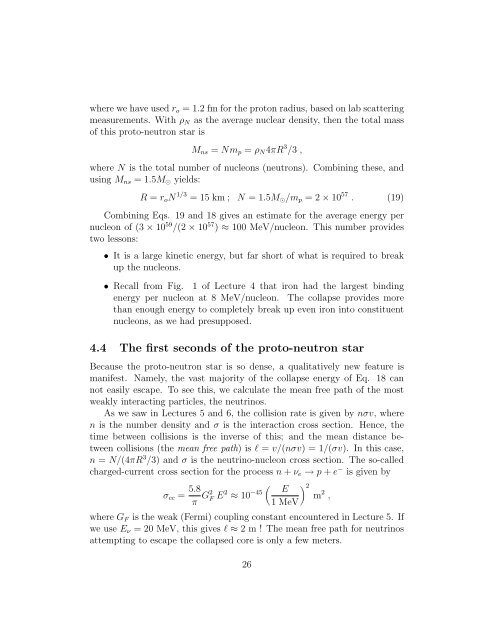Lecture Notes for Astronomy 321, W 2004 1 Stellar Energy ...
Lecture Notes for Astronomy 321, W 2004 1 Stellar Energy ...
Lecture Notes for Astronomy 321, W 2004 1 Stellar Energy ...
You also want an ePaper? Increase the reach of your titles
YUMPU automatically turns print PDFs into web optimized ePapers that Google loves.
where we have used r o = 1.2 fm <strong>for</strong> the proton radius, based on lab scattering<br />
measurements. With ρ N as the average nuclear density, then the total mass<br />
of this proto-neutron star is<br />
M ns = Nm p = ρ N 4πR 3 /3 ,<br />
where N is the total number of nucleons (neutrons). Combining these, and<br />
using M ns = 1.5M ⊙ yields:<br />
R = r o N 1/3 = 15 km ; N = 1.5M ⊙ /m p = 2 × 10 57 . (19)<br />
Combining Eqs. 19 and 18 gives an estimate <strong>for</strong> the average energy per<br />
nucleon of (3 × 10 59 /(2 × 10 57 ) ≈ 100 MeV/nucleon. This number provides<br />
two lessons:<br />
• It is a large kinetic energy, but far short of what is required to break<br />
up the nucleons.<br />
• Recall from Fig. 1 of <strong>Lecture</strong> 4 that iron had the largest binding<br />
energy per nucleon at 8 MeV/nucleon. The collapse provides more<br />
than enough energy to completely break up even iron into constituent<br />
nucleons, as we had presupposed.<br />
4.4 The first seconds of the proto-neutron star<br />
Because the proto-neutron star is so dense, a qualitatively new feature is<br />
manifest. Namely, the vast majority of the collapse energy of Eq. 18 can<br />
not easily escape. To see this, we calculate the mean free path of the most<br />
weakly interacting particles, the neutrinos.<br />
As we saw in <strong>Lecture</strong>s 5 and 6, the collision rate is given by nσv, where<br />
n is the number density and σ is the interaction cross section. Hence, the<br />
time between collisions is the inverse of this; and the mean distance between<br />
collisions (the mean free path) is l = v/(nσv) = 1/(σv). In this case,<br />
n = N/(4πR 3 /3) and σ is the neutrino-nucleon cross section. The so-called<br />
charged-current cross section <strong>for</strong> the process n + ν e → p + e − is given by<br />
σ cc = 5.8<br />
( ) E 2<br />
π G2 F E 2 ≈ 10 −45 m 2 ,<br />
1 MeV<br />
where G F is the weak (Fermi) coupling constant encountered in <strong>Lecture</strong> 5. If<br />
we use E ν = 20 MeV, this gives l ≈ 2 m ! The mean free path <strong>for</strong> neutrinos<br />
attempting to escape the collapsed core is only a few meters.<br />
26













